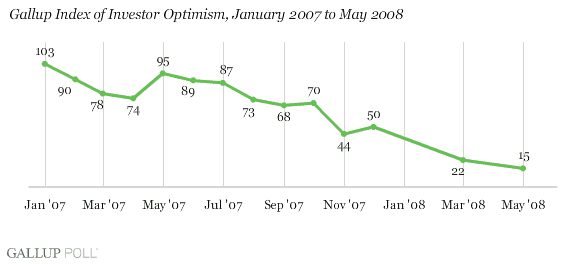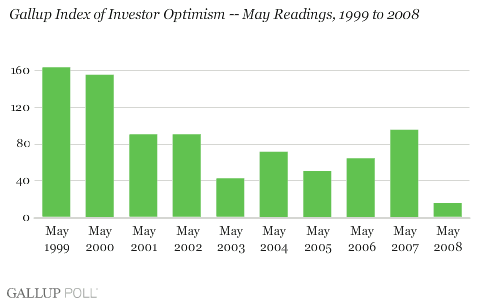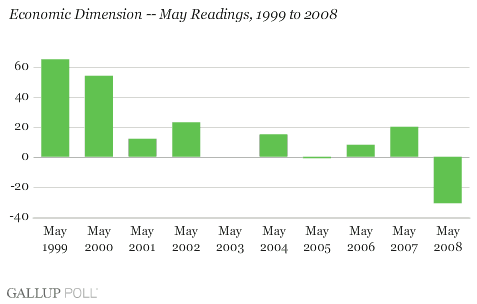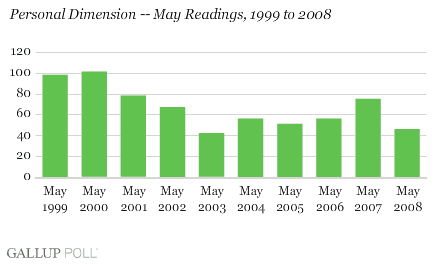PRINCETON, NJ -- Investor optimism tumbled to its lowest level since the beginning of the Iraq war, as the Gallup Index of Investor Optimism fell to 15 in May -- down from 22 in March, 95 in May 2007, and 103 in January 2007.

Investors Pessimistic About the Economic Outlook
The May Index reading of 15 is far below the 95 of a year ago, and is the Index's lowest level for May since its inception in October 1996. However, the Index remains slightly above its March 2003 low point of 5. The Index hit its all-time high of 178 in January 2000.

Investors remain pessimistic about the economic outlook for the year ahead, with the Economic Dimension of the Index at -31. This reflects less investor economic pessimism than the -40 of early March, which might be expected because the March measurement took place prior to the Bear Stearns bailout. Investors are currently as pessimistic about the economic outlook as they were in March 2003, at the outset of the Iraq war, when the Economic Dimension was at -30.

Investors' optimism about their portfolio investments over the next 12 months has also decreased. The Personal Dimension of the Index is at 46 in May -- down from 62 in March and 75 in May a year ago, and the lowest point for this dimension of the Index since May 2003, when it was at 42.

Commentary
Gallup's Index of Investor Optimism suggests that the average American investor is a lot less optimistic than the professionals on Wall Street about the current investment outlook. In particular, average investors remain pessimistic about the prospects for the U.S. economy -- not as pessimistic as they were when the Bear Stearns financial crisis was developing, but still at their pre-2008 pessimistic high.
Nothing indicates the divide between Wall Street and the average U.S. investor more than the way many of those on the Street are cheering the recent uptick in interest rates and the speculation that the Fed could actually increase interest rates later this year. Right now, the American consumer faces major challenges ranging from surging food and energy prices to plunging housing prices and a lack of job growth. The last thing Main Street needs is higher interest rates.
It is true that the global financial markets are highly emotional and it is argued that they tend to look past short-term economic events and focus on the 6 to 12 months ahead. Many on Wall Street seem to feel the U.S. economy will perform much better in the second half of 2008 and into early 2009. Gallup's Index of Investor Optimism suggests that the average U.S. investor is not nearly so confident that such will be the case.
Survey Methods
Results for this Gallup Panel study are based on telephone interviews with 576 investors, aged 18 and older, with at least $10,000 in investable assets, conducted May 19-21, 2008. Gallup Panel members are recruited through random selection methods. The panel is weighted so that it is demographically representative of the U.S. adult population. For results based on this sample, one can say with 95% confidence that the maximum margin of sampling error is ±5 percentage points.
Results for March are based on Gallup Poll Daily interviews conducted Feb. 28-March 2, 2008, with 1,947 investors with at least $10,000 in investable assets. For results based on this sample, the maximum margin of sampling error is ±2 percentage points.
For investor results prior to 2008, telephone interviews were conducted with at least 800 investors, aged 18 and older, with at least $10,000 of investable assets. For the total sample of investors in each of these surveys, the maximum margin of sampling error is ±4 percentage points.
In addition to sampling error, question wording and practical difficulties in conducting surveys can introduce error or bias into the findings of public opinion polls.
To provide feedback or suggestions about how to improve Gallup.com, please e-mail feedback@gallup.com.
